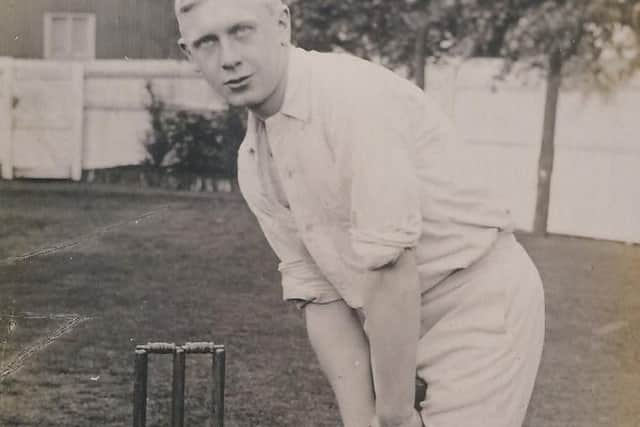Andrew Radd - The centuries might change but many big issues remain the same


Not to mention concerns that the recreational game involves too much travelling, making it difficult for their members to spare the time to play.
There are rumours of a split between Northampton-based teams and those from elsewhere in the county, with the key question being asked – is our current structure sustainable?
Advertisement
Hide AdAdvertisement
Hide AdAnd the powers-that-be at Wantage Road are sticking their oar in, too.


This column is nothing if not topical with its finger firmly on the pulse of the very latest developments.
Well, sometimes.
In this case, though, we’re talking about debates that raged over a century ago – the first time clubs considered the possibility of a properly-constituted countywide competition to pit the best against the best.
You thought that idea only dates back as far as Freddie Brown and the formation of the Northamptonshire County League in 1951? Think again.


Advertisement
Hide AdAdvertisement
Hide AdAnd the echoes from those distant summers just before the First World War will sound familiar to anyone who follows our Saturday afternoon cricket today.
It all started with an experiment in 1909 involving the two main leagues at the time – the Northampton, founded (initially as a ‘Challenge Cup’ tournament) in 1886, and the Kettering & District which came along a decade later.
The plan was to establish a joint competition for the leading clubs in each, with matches played on alternate Saturdays.
This meant teams would still battle it out for their own ‘home’ league’s title as well.
Advertisement
Hide AdAdvertisement
Hide AdIts first edition was a pretty low-key affair, won by Northampton club St Katherine’s. They duly celebrated with a dinner at the town’s Angel Hotel at which ‘the beautiful cup adorned the top table’.
A quick game of heads-and-tails before the meal? Probably not.
But the local cricket fraternity was sufficiently enthused to gather early in 1910 and ponder whether ‘the experiment…is to be tried again for the coming season, along slightly extended lines’.
As with Brown’s initiative 40-odd years later, the stated objectives were to raise the overall playing standard and discover talent for Northamptonshire’s county team.
Advertisement
Hide AdAdvertisement
Hide AdOne of my journalistic predecessors – ‘Spectator’ in the Northampton Mercury – was an early fan.
‘Such a competition would give impetus to the game in the country districts, and (NCCC) would be given greater opportunities than they have at present of unearthing any promising young players and giving them a thorough trial,’ he (or she) wrote.
Positive stuff. Except that those two words - ‘country districts’ – reveal a patronising view of cricket outside Northampton that would eventually dog the new-born ‘joint league’.
By the end of 1910 the bandwagon looked to be rolling in a big way.
Advertisement
Hide AdAdvertisement
Hide AdThe honorary organising secretary at the County Ground, Percy Dale, summoned the interested parties to a meeting in his insurance office – and the agenda included a suggestion that clubs in the Peterborough and Brackley areas should also be invited, ‘the league thus embracing the whole of the county’.
But the first rumblings were already audible.
Mount Pleasant and Clarence, two of the Northampton teams, baulked at the cost of the whole thing. Raunds’ application to join was turned down ‘owing to their geographical position and the unfeasibility of arriving there and returning for an afternoon match’.
There was also a call for neutral umpires – shelved for the time being.
Sadly, and perhaps crucially, Percy Dale died suddenly on the eve of the 1911 season. One of the competition’s strongest supporters had left the crease.
Advertisement
Hide AdAdvertisement
Hide AdBut that summer was a superb one weather-wise, and the league was given a timely fillip early on when ‘Tubby’ Vials – Northamptonshire’s new captain – hit an unbeaten century in it, for Clarence against Desborough.
By August, four teams – Clarence, Rushden, Rothwell and Kettering Athletic – were in contention. In the end, the first two named shared the title because it was too late in the season to arrange a play-off.
All fine-and-dandy? Emphatically not. The natives (of Northampton) were growing decidedly restless.
By January 1912 a rescue mission was underway after the townies threatened to pull out. Their principal grouses? You’ve guessed it – money and umpires.
Advertisement
Hide AdAdvertisement
Hide AdA crisis meeting in the Whitworth Road Conservative Club – a short walk from the County Ground – heard that ‘men working in factories in Northampton could not leave their employment until 12.30pm and the train serving the district in which the country clubs (here we go again) were situated left Northampton at 1.10pm’.
Players, it was claimed, ‘could not be called upon to make a sacrifice they could not afford’.
Rothwell, apparently, was the worst trip of all. And that was without the A6 closure…
As for the men in white coats – some of the town clubs insisted that the officials provided by their country counterparts were ‘unfair and biased’.
Advertisement
Hide AdAdvertisement
Hide AdVials, diplomatically, disassociated himself from those remarks, and continued to play in the competition whenever County commitments allowed.
It took a grant from NCCC to keep the show on the road for 1912, and Lord Lilford even offered gold medals to the winners – duly presented to Rushden who beat Temperance by 88 runs in the Championship final at Wantage Road.
It’s worth listing the seven ‘country’ clubs who competed that season – Rushden, Rothwell, Burton Latimer, Finedon Dolben, Earls Barton, Desborough and Kettering Athletic. Many familiar names there to 2017 cricket-watchers.
In contrast, nearly all of the Town teams – Temperance, Star, Clarence, Mount Pleasant, St Katherine’s and PM Excelsior – are long-gone.
Advertisement
Hide AdAdvertisement
Hide AdThe joint league continued for another two years. In 1913 a row erupted between Finedon and Excelsior after the scorers’ books failed to tally – had the Dolben won or was it a tie? The committee was called in…
In 1914 a combination of war (which broke out on August 4) and rain prevented the competition from being completed. When clubs reconvened five years later the old ‘regional’ leagues held sway again.
Until, of course, a certain FR Brown intervened.
But if this story has a moral – it’s simply that, in the politics of Northamptonshire club cricket, there’s nothing new under the sun.